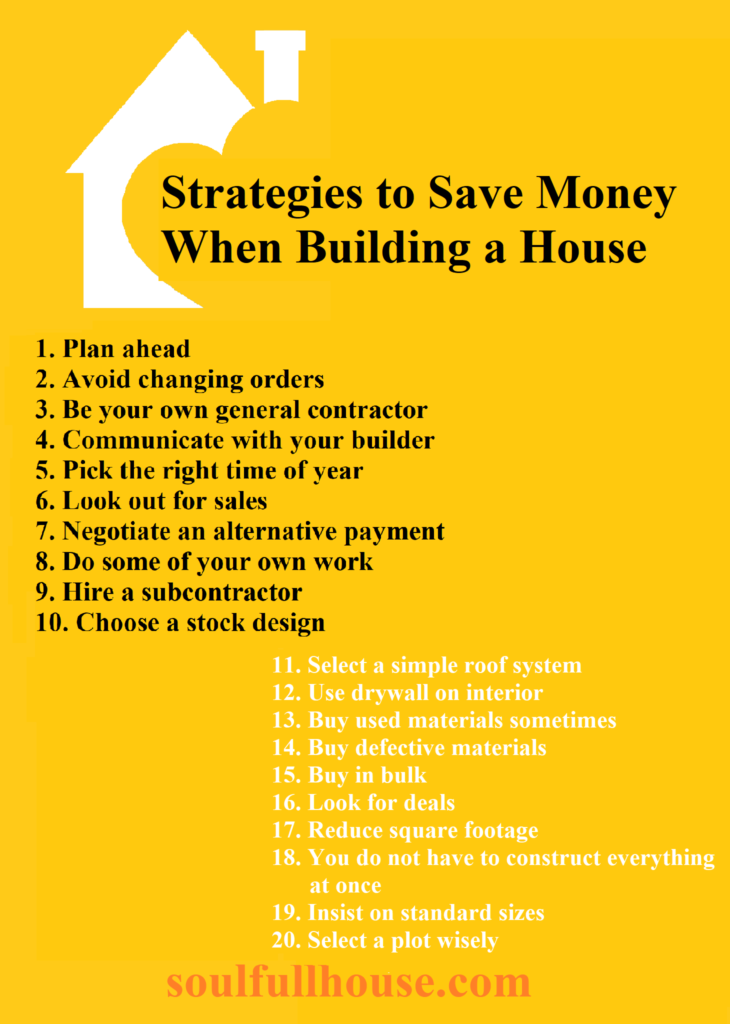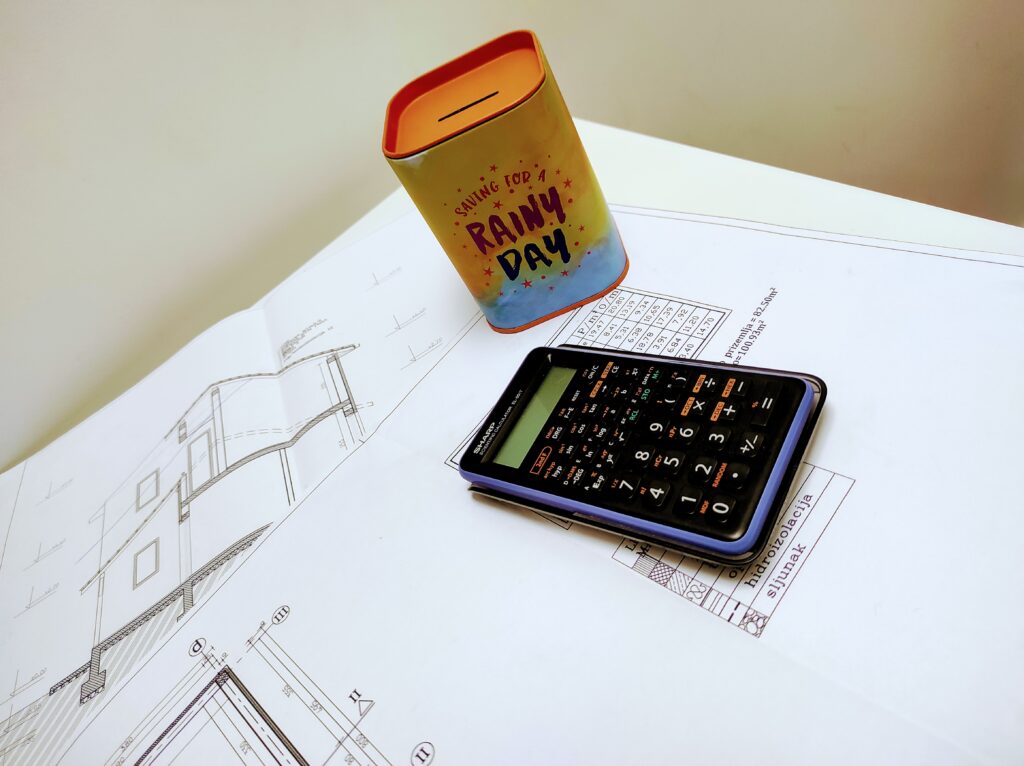Building a house can be an expensive venture, but there are several methods that you can use to save money and reach your ultimate goal – soulful house!

What methods are there for saving money when building a house?
There are three basic methods where you can make savings when building a house: by sacrificing time, quality or quantity. Understanding what is most important to you and making smart decisions will help you create a beautiful home without breaking the bank. Below, we have outlined ways to help you save money when building your own home.

There is an anecdote about the best auto mechanic in town, who hung a big sign at the entrance that said: QUICK – QUALITY – CHEAP. Choose two of those!!! This is a fundamental rule of life that, in my experience, can be applied practically always and everywhere.
TIME:
Of course, everyone desires to construct a home as soon as possible. Efficient and quick construction can occasionally save money on things like rent for an apartment during construction, travel expenses, and so on. The most crucial benefit is that it saves nerves. However, if the goal is to go as cheaply as possible, this is the ideal technical approach because both quality and quantity are unaffected. Only the total length of construction and your participation amount increase.
1. Plan ahead: While planning ahead is crucial for any job, it is especially critical when building a house. Planning ahead of time will help you anticipate potential delays or unforeseen charges, as well as keep you on budget.
2. Avoid changing orders: Change orders are last-minute adjustments in design or supplies that can quickly drain your budget. One last piece of advice? Stick to the plan as best you can. Changing your mind once work has begun is an incredibly expensive task. In reality, plan revisions not only incur material and labor costs, but builders will often charge a 20% premium.
3. Be your own general contractor: Managing the project yourself can save you more than 20% of the entire cost of construction. Because choosing and organizing experienced subcontractors will be your primary duty, you will require a basic understanding of the construction process. You can certainly manage a home development if you’re a natural problem solver, a people person, and efficient at managing budgets and timelines.
4. Communicate with your builder: Many problems encountered throughout the building process can be attributable to a lack of communication. Before they begin, don’t be hesitant to ask questions and go through construction features with your builder. It’s always cheaper to get it right the first time rather than to tear something out and start over.
5. Pick the right time of year: The time of year you build is an often overlooked tip to save money on construction expenditures. Late autumn is usually the cheapest season to build in colder climates. Summer and spring are typically the most expensive season. The reason is straightforward. Construction slows down in the winter, which means that more companies are desperate for work and are willing to accept cheaper bids just to keep the cash coming and their trained personnel employed. Then, once the busy season arrives, contractors can “pick and choose” which tasks they want because there is frequently such a glut of projects, raising the price.
6. Shop online for deals and look out for sales (flooring, tiles, windows, paint…): Prices vary greatly from one provider to the next. Spend time looking for the best deal, but don’t be afraid to use web technologies as well. Through a tender or auction, several platforms allow bidders to compete for the best offer for your material specification.
7. Negotiate an alternative payment: It should never be forgotten that contractors also need all kinds of services and goods. Maybe you can provide some of that or you know someone (friend, relative, neighbor…) who can do it, and he owes you a favor…??? In any case, it is worth trying to make such a non-monetary arrangement and save over the much needed cash.

QUALITY:
The house should be built as high quality as possible because this directly influences its market value, durability, and housing quality. However, for the purpose of saving, you should prioritize adequate quality over perfect quality.
8. Do some of your own work: Doing some of your own work is a terrific method to save money on labor prices. Even if you have no building knowledge, you may undertake many jobs yourself, such as painting and laying tiles. Furthermore, by doing some of the labor, you may ensure the project continue even if there are delays.
9. Hire a subcontractor: Certain components of the job, such as electrical and plumbing work, require the hiring of a subcontractor. It is, however, critical to look around and obtain various estimates to verify that you are getting the best deal. It is also critical to conduct research and ensure that the contractor is experienced and dependable.
10. Choose a stock design: Custom designs are more expensive in terms of design time, materials, and labor. Most home makers have dozens of stock plans that they have built on numerous occasions. Many faults have been removed in these designs, allowing them to be installed smoothly and efficiently, saving you time and money.
11. Select a simple roof system: One of the most expensive material and labor line items in your budget is the roof. As a result, the simpler the roof system, the lower the cost. A basic, single ridgeline with a shallow pitch is the most cost-effective roof. More complex roof systems with steeper pitches, known as hips and valleys, are more visually appealing. They are, however, far more expensive. Leaving out unnecessary features is not a sign of weakness. Rather, it is about making wise home investment decisions. Multi-level pitched roofs, cathedral ceilings, and intricate cornices can cost tens of thousands of dollars, but for what?
12. Use drywall on interior: Pine paneling on the interior of your ceiling looks great. However, it’s roughly twice the cost of drywall—and cedar paneling is even more expensive than pine.
13. Buy used materials sometimes: This may appear to be a desperate move, but it is not. Please bear with me! The material has only a beneficial role in some works. Just because it has been used and does not look perfect does not indicate it will perform poorly. You will save money and the environment will benefit. In some circumstances, the material utilized contributes to the home’s beauty and warmth. Consider brick, wooden beams, or a floor…
14. Buy defective materials: When discussing the purchase of damaged material, it is critical that it be both constructively and aesthetically correct. In this scenario, the reverse logic from the first step is correct. You should buy more than you need, set aside and discard unsuitable items, and the savings are achieved on a significant price difference compared to the usual.

QUANTITY:
There is always a thirst for more in today’s civilization, which is founded on the pillars of consumer culture. However, we must consider what are our true necessities and what are fads, and the savings are self-imposed.
15. Buy in bulk: Buying in bulk is one of the most cost-effective strategies to save money when building a house. Buying in bulk will drastically lower material costs and be more efficient because you won’t have to make several journeys to the store.
16. Look for deals: The greatest approach to locate bargains on materials and supplies is to shop around. You can locate the greatest pricing by checking online, in stores, and at trade exhibitions. Furthermore, you may be able to find used materials or supplies for the job.
17. Reduce square footage: Reducing the square footage of the entire home is one technique to drastically reduce costs. To save money, think tiny and cozy. Another wise method is to construct upward with a two-story plan rather than outward, as with a ranch design.
18. You do not have to construct everything at once: Start with wholesale cabinets and countertops and improve kitchen later. Bathrooms, like kitchens, feature a range of materials that can be upgraded afterwards. If you desire a whirlpool tub in your master bath but can’t afford it right now, order a soaking tub of the same size from cheaper manufacturer. In the future, swapping it out will be a breeze.
19. Insist on standard sizes: Whether you choose off-the-shelf plans or a custom design, ensure sure the windows and doors are all standard sizes. Customization is required for odd-sized or shaped windows and doors, which can raise the overall cost of purchase and installation. You can also look for leftovers at construction supply businesses, which frequently have conventional windows and doors priced to sell.
20. Select a plot wisely: The plot you choose can actually make or break your build and its accompanying budget. Start researching the area you want to invest in to make the best decision possible. Examine the area’s expansion and current infrastructure; does it fit your lifestyle? After you’ve investigated the neighborhood, it’s time to evaluate the property itself. Examine the property for easements. Conduct soil testing to ensure you select the best foundations for your property. Determine whether or not the terrain is sloping. If this is the case, the construction will be more expensive.
Conclusion. Building a house is a huge investment, and finding ways to save money without sacrificing quality can be challenging. However, with careful planning and smart decision-making, it is possible to build your dream home while staying within your budget. By prioritizing your needs and wants, negotiating with contractors, doing some of the work yourself, and looking for deals and sales, you can save money on both labor and materials. Remember that a little effort and creativity can go a long way in reducing your overall costs, while still ensuring a high-quality and beautiful home.
